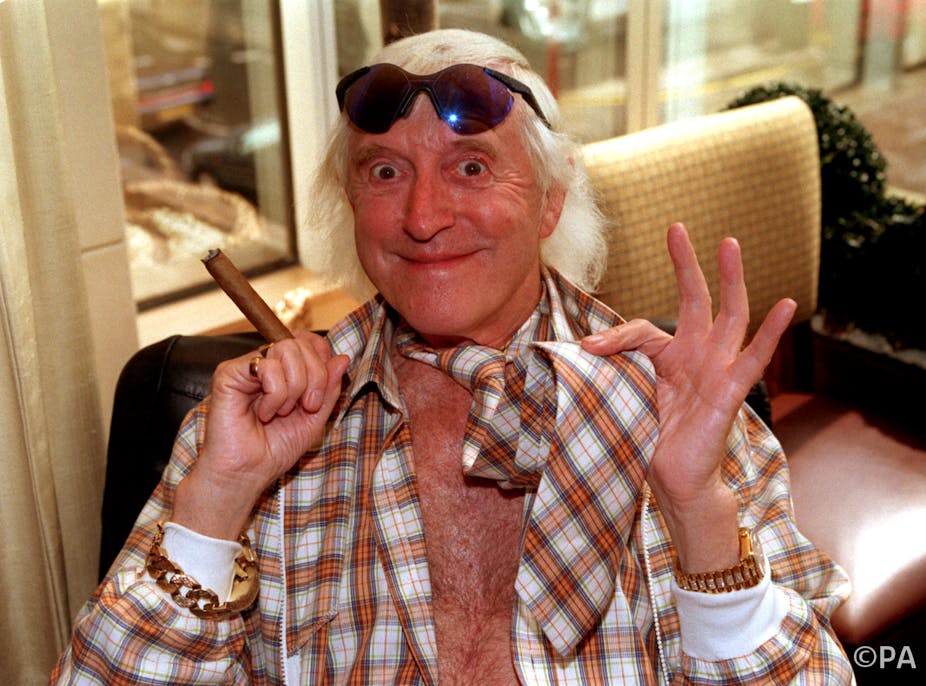In the opening statement in her report on Jimmy Savile’s years abusing girls, boys, women and men at the BBC, Dame Janet Smith refers to a “macho culture” as an important element that enabled Savile to get away with decades of criminal behaviour. She may have absolved the BBC of institutional responsibility, but director general Tony Hall has accepted that the question of whether BBC bosses knew of Savile’s abusive behaviour does nothing to address the question: “How could you not have known?”
In this sense, the “macho culture” Smith identifies takes on an institutional character – institutional sexism – which the BBC clearly can and must tackle. Yet it is not the only institution where macho culture and sexism prevent us from seeing the reality of men’s abusive behaviours. The same problem is alive and well in the way the press has covered the story.
Savile’s abuse of women and girls at least was an open secret, existing, as the title of Dan Davies’ biography suggests, in plain sight. The problem wasn’t that people didn’t know. It was that – among other factors – the macho culture prevented them, prevented us, from recognising it as abuse.
Davies’ biography demonstrates how Savile was adept at implicating others. He notes, for instance, that Savile explicitly referred to sexual contact with teenage girls in his 1970s autobiography, and that he’d openly “joke” that his motto was “don’t get caught”. In the now infamous 1974 Clunk Click programme, where Savile hosted Gary Glitter, he joked about “giving” Glitter two girls before both men drape themselves over the young women on set. The TV audience at home saw this too, but most of us didn’t see it as abuse either. Celebrity men helped themselves to women, and too many of us went along with it.
Now then, now then
It would be nice to think this was a relic of a bygone age, but my work on more recent press reporting of Savile suggests there is no room for complacency. The UK press’s coverage of Savile between his death in October 2011 and three days after the ITV broadcast of Exposure in October 2012, which named him as a serial abuser of girls (the evidence of his abuse of boys came later), shows a similar sexist complicity to that of Savile’s addresses to journalists and on-screen behaviour.
At the time of his death, for instance, newspapers frequently referred to Savile as a “ladies man” or “womaniser”, also noting rumours of “underage sex”. The way he sexualised every interaction with women and girls – from incessant flirting to groping, demands for kisses, and comments on their attractiveness – was seen as part of what had made him a lovable eccentric. A national treasure.

Even when the stories of abuse first emerged, this perception persisted. They were labelled, in a variety of contexts, as “sex claims”, allegations of “child sex” and “underage sex”. Not: “sexual abuse claims” or “allegations of child sexual abuse”. This was at a time when coverage of Savile was dominated by stories relating to consensual sex (the emergence of a long-time hidden lover, and a potential love child). The abuse stories were arguably presented in a way that fitted this broader narrative – a narrative about sexual scandal and secrets - and initially the actual abuse was invisible.
For instance one of the first mainstream news outlets to cover the story (after it had been broken by The Oldie), was the Sunday Mirror, which ran with an intro about “sex claims”, referred to Savile’s “colourful lifestyle” and described him as “iconic” and a “cigar-chomping star”. Although this report was about the dropped BBC Newsnight investigation on Savile’s abuse of vulnerable young women and girls at Duncroft School, not once were the allegations described as allegations of abuse or assault. The most damning language was to suggest his behaviour was “inappropriate”. Euphemism and salaciousness trumped accuracy.
Even when the story became one of abuse, the persistence of the label “underage” is also disturbing. Think about the phrase “abuse of underage girls”. Isn’t there an implication here that there is an age at which one can consent to the kind of abuse Savile was accused of: groping, attempted rape, rape? That’s also why the persistent labelling of Savile as a paedophile is unhelpful. Yes, he abused children. But he also abused adults. Smith’s report isn’t a report exclusively about child sexual abuse: indeed, a majority of Savile’s BBC victims were legally adults. However, that they were over the age of consent is immaterial: they did not consent.
Fast forward four years to the day the report was released. The Mail Online, anticipating the report, ran with a headline: “Damning Jimmy Savile BBC Sex Report to be Released Today.” But Savile wasn’t damned for having sex at the BBC. He – and Stuart Hall – were damned for sexually abusing women, girls, (and in Savile’s case) men and boys at the BBC.
Surely one of the most potent legacies of the Savile case has to be that this conflation of sex and abuse in the media’s treatment of allegations against powerful men has no place in a civilised society.

